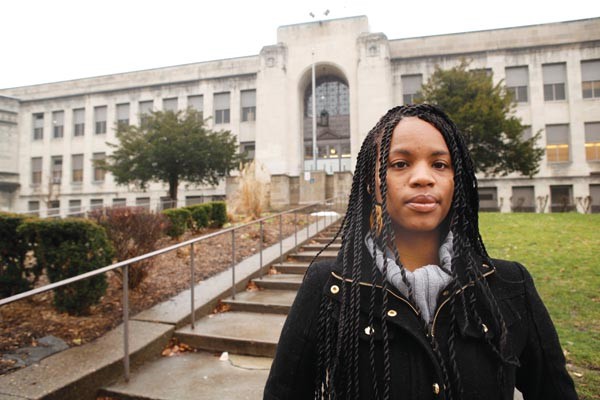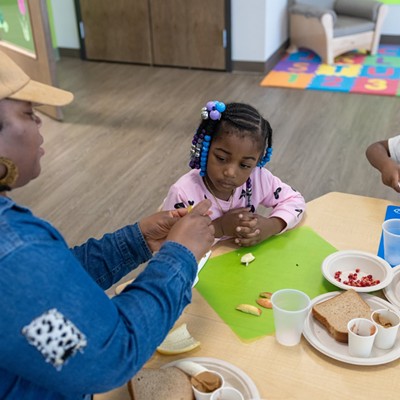Shauna Ponton is dreading Oliver High School's final bell.
After it sounds in June, Oliver students will move to nearby Perry High School, where they will begin the 2012-13 school year in a newly combined high school. Ponton's son graduated from Oliver last year, but as a concerned North Sider, she worries that the merger is destined to fail ... and that the community as a whole will suffer.
Since the board approved the move in November, Ponton says parents, students and teachers have largely been left in the dark about the district's plans to merge the two schools.
"Parents are confused," says Ponton. "You can't wave a magic wand and think this is going to work."
District administrators maintain that the district has been working diligently to ensure a smooth transition. And they plan to increase their community-outreach efforts between now and the end of this school year.
They'll certainly need to: North Side residents are all too aware of the turmoil at Westinghouse High School, which is still reeling from a once-touted restructuring the district scrapped last year.
"The district needs to put this plan on hold," Ponton says. "It's going to be Westinghouse Part II."
The Oliver/Perry merger is one part of a sweeping realignment plan meant to help the Pittsburgh Public Schools dig itself out of a projected $68 million deficit. In November, the school board approved a slew of changes that included shuttering six other city schools — including Langley High School, which will merge with Brashear.
But it is the changes on the North Side that are drawing the most attention.
Located in the North Side's Marshall-Shadeland neighborhood, Oliver houses career- and technical-education programs like cosmetology and culinary arts. It also boasts a Junior Reserve Officer Training Corps (JROTC) program, and another for law and public service.
Perry, located nearby in Perry North, is a "magnet school," whose math and science program is designed to entice students from across the city.
District officials say that each school's programs will remain intact after the merger. Oliver's JROTC program will be housed at Perry, for example. But for programs like culinary arts and cosmetology, students will be taken by shuttle bus back to Oliver, which is properly outfitted for them.
The merger is necessary, administrators say, because when the schools are considered separately, the numbers don't add up.
The Oliver building has the capacity to hold nearly 1,800 students, but currently houses only 350. Perry, meanwhile, has just 640 students in a building designed to house more than 850.
"The biggest concern with both Oliver and Langley is the very low enrollment," says Nancy Kodman, the district's executive director of academics and operations integration. The district simply can't afford the cost of keeping both schools open, she says.
Some parents have wondered why the district isn't retaining Oliver, which is larger and which will still be used for some classes. Kodman says closing Perry "was looked at," but officials based their decision on numerous criteria, including building condition and student achievement. "They each had pros and cons," she says.
In fact, neither school's test scores are anything to brag about. In 2011, just 32 percent of Oliver's 11th-grade students scored proficient or advanced in reading on state exams; only 16 percent scored the same in math. Scores at Perry were better, but still lagged behind the district average of 59 percent proficient or better in reading, and 48 percent in math.
Oliver principal Dennis Chakey admits that students were upset upon learning that their school would close. But he says that changed once students realized they'd have more academic choices, including extracurricular activities, in a merged school.
"They're starting to become excited," Chakey says.
So are students at Perry, says Nina Sacco, the principal there. Students from the same part of town attend both schools, she says: "They're friends."
Or not.
"Oliver [students] are going to think they run Perry," says Marena Sasala, a Perry freshman.
Sasala's friend Mikenna Livingston, also a freshman, says she's "OK" with the merger. But she says, "There's going to be a lot of drama."
Livingston says Perry teachers have spoken openly about dreading the merger. "They said they don't want Oliver coming because there's going to be chaos" in the classrooms.
Rivalry between the schools "is a very real thing," says Shanon Williams, a 2006 Oliver graduate who helped organize a Jan. 23 press conference to demand more information about the merger. Williams said fights have broken out when the schools have played each other at football games, and that rivalries extend beyond sports. "These kids automatically have a vendetta against each other," she says. "If they merge without planning for that social dynamic, it's going to be a hostile environment."
Mark Fatla, executive director of the Northside Leadership Conference, says he's "glad people are worried, because they should be." Fatla says the NSLC's education committee held a meeting on Jan. 10 to discuss the school merger. "The feeling was expressed that we really haven't been hearing anything about what the district's plans are and how they're going to make this work."
School officials are downplaying such concerns: "We always worry the students are going to fight, and we're going to have problems," says Kodman. "But students generally do OK." And they are taking steps to address such problems head on.
Fatla learned on Jan. 26 that the district is planning further community discussions — something he says is "a good sign." Officials have, meanwhile, dubbed February "Welcoming Month," and hope to have every Oliver student tour the building, familiarizing themselves with students and staff there.
But uncertainty remains — in no small part among the teachers themselves.
"Nothing has been put out from the board about what will happen to Oliver teachers," said one Oliver teacher, who insisted on anonymity because of concerns over her future employment. "Teachers are very concerned about their jobs."
Indeed, district officials aren't talking about possible layoffs, saying staffing decisions have yet to be made.
"Oliver parents are very concerned," one Oliver teacher said. "As of today, we have not had any kind of joint meetings with the parents and students of both schools. This is ridiculous. ... With mergers, you have to make sure parents and students are embracing it. You want to do everything possible to ease the transition."
Magnifying these concerns is fallout from earlier reforms carried out in the East End. In the fall, school officials launched an overhaul of Westinghouse, which included a grade 6-12 configuration and single-gender classes. The moves were supposed to improve the long-troubld school, but things got worse. The single-gender classes drew legal threats from the American Civil Liberties Union, and there were complaints that the curriculum changes had been poorly planned and executed. The district rolled back the changes in November.
"I don't have a lot of confidence that we won't see a repeat of Westinghouse," says state Rep. Jake Wheatley, who represents the North Side and serves on the state House's education committee. "This is not to say this is doomsday, but [the district] needs to open their eyes and ears [to the community]."
How can North Siders be sure that their high-school restructuring will be handled any better?
"I've gotten this question multiple times now: Can you do this right?" says Pittsburgh Superintendent Linda Lane.
Lane says it's misleading to compare the Oliver/Perry merger to the transition at Westinghouse. The Westinghouse merger involved more than just combining two schools, she points out: Most of the problems, she says, stemmed from reconfiguring the school year from semesters to trimesters. (And there will be no controversial same-sex classes in the North Side.)
And while Lane admits "I am not pleased or proud of the Westinghouse transition," she adds "there is also a record of being able to do [school transitions] well." As examples, she cites the creation of CAPA 6-12, Downtown, and Milliones UPrep 6-12, in the Hill District. Such restructurings have proceeded more smoothly, even if — as at Milliones — test scores and student achievement have not met expectations.
Kodman, who is in charge of the district's school transitions, says the district has learned some lessons from the Westinghouse transformation. Both Oliver and Perry, she says, have created "transition teams," composed of students, staff and community members. Those teams, which were formed in December, are tasked with preparing each school for the merger. (Their preliminary plans were due to the district on Jan. 27.) And this time around, Kodman says, district administrators will be less hands-off than they were at Westinghouse.
"We learned that it's better to have [mergers] under the central management ... for consistency and monitoring standards," she says.
District officials, and students, will find out soon enough whether that will make a difference. In the meantime, the principals at Oliver and Perry are hoping for the best.
"When you merge two schools, it's sad," acknowledges Sacco, Perry's principal. "But ... we have an exciting opportunity in front of us.
"I think we'll have a seamless transition."















